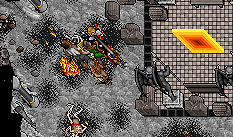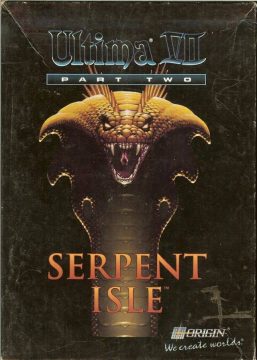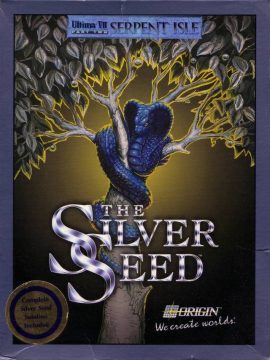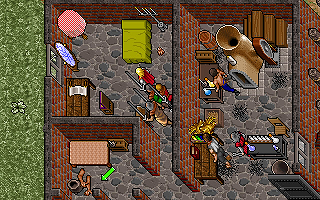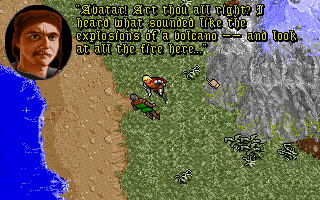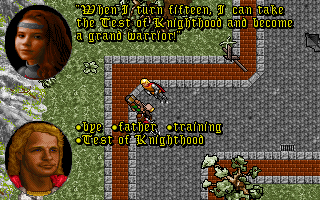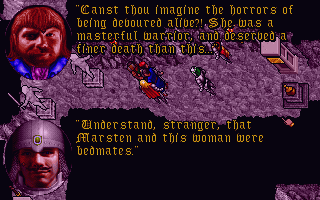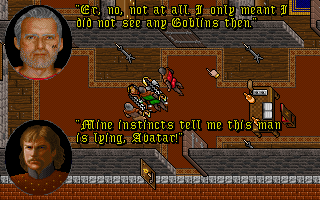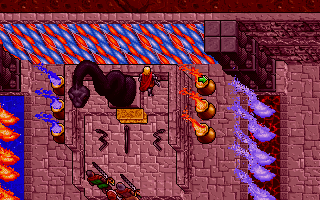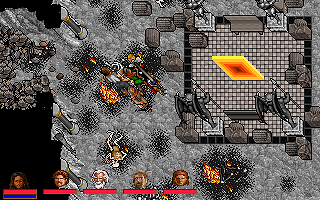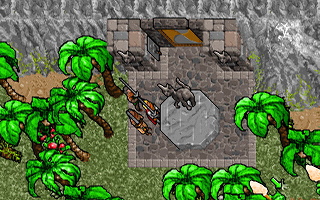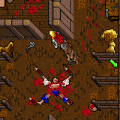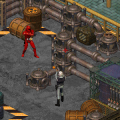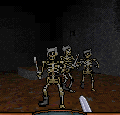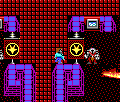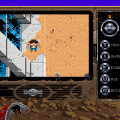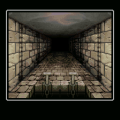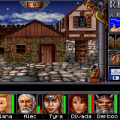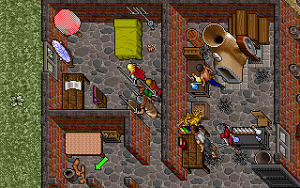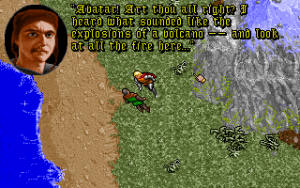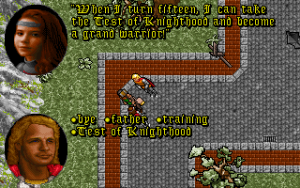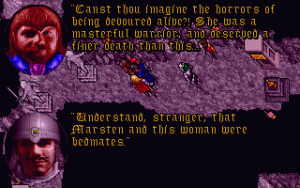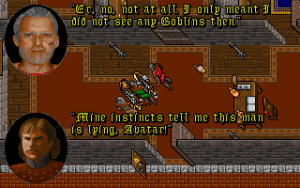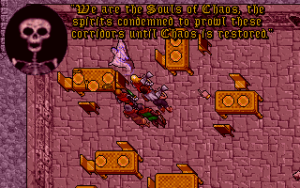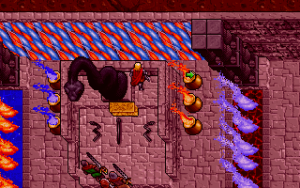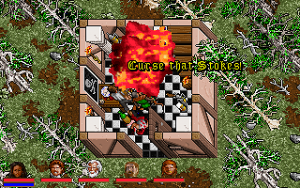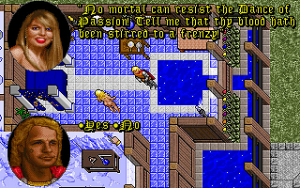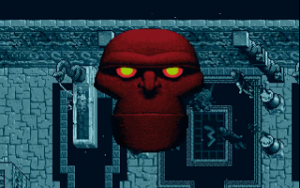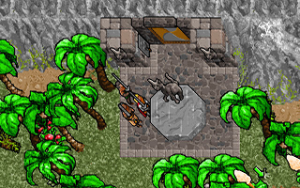- Ultima (Series Introduction)
- Akalabeth
- Ultima I: First Age Of Darkness
- Ultima II: Revenge of the Enchantress
- Ultima III: Exodus
- Ultima IV: Quest Of The Avatar
- Ultima V: Warriors of Destiny
- Ultima VII: The Black Gate
- Ultima VI: The False Prophet
- Ultima VII Part 2: Serpent Isle
- Ultima VIII: Pagan
- Ultima Underworld: The Stygian Abyss
- Ultima Underworld II: Labyrinth of Worlds
- Arx Fatalis
- Worlds of Ultima: The Savage Empire
- Ultima Worlds of Adventure 2: Martian Dreams
- Ultima IX: Ascension
- Lord of Ultima
- Ultima Online
- Ultima: Escape from Mt. Drash
- Ultima: Miscellaneous
- Richard Garriott (Interview)
Eighteen months after the destruction of the Black Gate and the foiling of the Guardian’s plans for Britannia, a scroll is discovered in the personal effects of the Fellowship’s founder and the Guardian’s right-hand minion Batlin. It contains a message to the effect that, in the unlikely event the Avatar should stop him, Batlin must immediately escape to the isolated Serpent Isle where the Guardian has set back-up plans in motion. Lord British, worried, sends the Avatar, now forever trapped in Britannia since destruction of the Black Gate, to investigate. Coming with him are his companions Iolo, Shamino and Dupre; Iolo has his own agenda, as his wife Gwenno left to explore the Serpent Isle more than a year ago and hasn’t been seen since. Sailing past the great Serpent Pillars of the arctic seas, you reach the strange new land, but disaster (of course) strikes almost immediately. Now, separated from your companions, separated from your demon-infused Black Sword, and stranded on the Serpent Isle, the Avatar must find Gwenno and his companions and foil whatever plans the Guardian has set in motion.
Serpent Isle plays near identically to The Black Gate, using an engine with only minor enhancements. The inventory system has been changed to show paper doll images of your party members with equipment shown directly on them, and the small dialogue portraits of The Black Gate have been replaced with large high-color pictures of photographic quality (several portraits in the game are actually those of Richard Garriott’s friends or employees of Origin, including Denis Loubet, Warren Spector, Greg Dykes and others). The keyword dialogue system, graphical and sound effects, world complexity and interactivity and the rest is all intact. The majority of differences between this and past series entries is instead the setting.
For the first time since Ultima III: Exodus in 1983, a mainline Ultima game does not take place in the Britannia that players have come to know like an old friend over the years. The setting is instead moved to the Serpent Isle, a mysterious land beyond a portal in Britannia’s icy reaches. Serpent Isle is a completely different world, populated by the descendants of refugees from old Sosaria who left between the events of Exodus and Quest of the Avatar. Despite the impression given in earlier games of a universally beloved, benevolent monarch, it turns out that not everybody agreed with Lord British’s way of doing things, and especially his system of Virtues. The people of Serpent Isle call their land New Sosaria, and spurn “Beast British”, a malefic tyrant who called world-changing horror down upon them and attempted to institute an arbitrary and draconian series of ethics of his own devising.
In theory the New Sosarians had fair reasons for disliking the British Virtues; the three city-states of Monitor, Fawn and Moonshade believed respectively in the superiority of Courage as a value, that Beauty should be a virtue, and that Honesty was a ludicrous thing to define mages with, as magic is inherently illusory. In practice, however, the people of Monitor are endlessly feuding brutes, the people of Fawn a lot of shallow narcissists, and the mages of Moonshade untrustworthy and corrupt. The Serpent Isle is a very different place from Britannia, dangerous and rough, and the Avatar’s principles are constantly tested throughout the game. In the words of Richard Garriott, “The central subtext of the story to Ultima VII is that, when the fabric of society becomes weak, it’s very easy to have evil inflict itself on you”. The Serpent Isle is a society that encourages shallowness, classism, selfishness and corruption, and whether the behavior of the people is due to their culture or their own flaws is a question that needs to constantly be asked. The game’s story is convoluted, complex, and well-presented and told; on his quest to find Batlin and rescue Gwenno, the Avatar must deal with the inhabitants of the Serpent Isle and learn the ways of the vanished Ophidian culture whose relics scatter the islands. Many long-time Ultima fans consider Serpent Isle‘s plot to be the best in the series, and it only contributes to the perception of the complete Ultima VII as the pinnacle of the franchise.
Like Forge of Virtue, Serpent Isle continues the proud Ultima tradition of shamelessly re-writing the stories of previous games to fit them all together more smoothly and expand the lore. More than any other game in the series, this one rewards long-time fans who have been present from the beginning way back in the early ’80s. The Serpent Isle, it is eventually discovered, is one of the lost three continents from Ultima I, vanished when Mondain’s gem of immortality was broken, and since then having developed its own culture and virtues. Shamino’s past as one of Ultima I’s generic quest-giving kings is addressed and his backstory expanded, and various other easter egg references to earlier games pop up. Combined with an unusually large amount of unfinished content left in the game, Serpent Isle becomes one of the most rewarding video games ever published for gamers who enjoy hunting for secrets and hidden things.
Serpent Isle is rewarding for long-time Ultima fans in other ways as well, due to the plot being heavily dependent on understanding a new set of virtues completely different from the Britannian or Gargoyle ones. The Virtues have always been a defining characteristic of the series and one of Richard Garriott’s most original contributions to computer gaming, an aid to role-playing and a genuinely fun game mechanic to get players thinking. For Serpent Isle, designers Sheri Graner Ray and Brendan Seagreaves created a completely new set of ethics that govern the world and which players must understand to finish the game, the Ophidian Virtues. The Ophidian Virtues, which seem to be heavily inspired by Michael Moorcock’s fantasy universe, focus on a balance between the forces of Chaos and Order and their associated principles. Unlike the Britannian Virtues, each principle is not a goal, but an aspect that must be in balance with its opposite.
The Ophidian Virtues
Chaos:
–Tolerance; to encourage acceptance of all things
–Enthusiasm; the energy needed to perform great deeds
–Emotion; the ability to perceive those feelings that come from the heart rather than the mind
Order:
–Ethicality; the belief that there is value in abiding by rules of conduct
–Discipline; the drive to complete a task and avoid distractions
–Logic; permits clear, reasoned thought free from instinct and bias
Balance
–Tolerance and Ethicality create Harmony, the ability to be at peace with oneself and the world
–Enthusiasm and Discipline create Dedication, that which allows one to surmount obstacles and lead others
–Emotion and Logic create Rationality, the ability to comprehend life and understand the world.
When either Chaos or Order is not balanced by their twin, this leads to an anti-force:
–Prejudice; ethicality without tolerance, a disrespect for the rights of others
–Apathy; discipline without enthusiasm, a spirit of hopelessness
–Ruthlessness; logic without emotion, acting for yourself without regard for the rights of others
–Anarchy; tolerance without ethicality, a lack of standards of conduct.
–Wantonness; enthusiasm without discipline, action without restraint.
–Insanity; emotion without logic, an inability to overcome impulses with rational thoughts.
Though the game isn’t quite as dependent on virtues as the Age of Enlightenment games, completing Serpent Isle requires understanding this system.
Serpent Isle has a storied development history. The game was originally intended to be a new Worlds of Ultima title, a game themed around snake-worshipping pirates, voodoo and swashbuckling. However, the two released Worlds of Ultima titles, Savage Empire and Martian Dreams, had disappointingly low sales and the outlook for the game wasn’t improved by the resignation of project lead Jeff George from Origin during development. After designer Bill Armintrout and Ultima Underworld producer Warren Spector stepped in, the game was redesigned to become more of a mainline Ultima title. A common misconception among casual players, that The Black Gate and Serpent Isle are really two halves of one game, isn’t actually true. As Richard Garriott felt that each new main Ultima should be completely new without reusing code, he felt like it would have been wrong to call the game Ultima VIII. The story does carry on from hanging plot threads in The Black Gate, but isn’t a direct sequel either (the events of Ultima Underworld II, where the Guardian attempts to take Britannia by force, take place between the two parts of Ultima VII). With the limited success of the Worlds of Adventure line and the change in focus of Serpent Isle, this became Origin’s last attempt at creating a standalone Ultima with an existing engine.
Electronic Arts, the new owner of Origin Systems, instituted a deadline on Serpent Isle‘s completion after Origin missed their goal of a Christmas 1992 release, which resulted in quite a bit of cut material (and one entire island not being reachable in-game), much of which is still in the code or physically present and leaves clues behind as to what else the writers at Origin intended to do. Notably, the game originally had a much longer 3D-animated introduction movie designed by Denis Loubet, which unfortunately would have taken up too much disk space to include. As a result of the time crunch for the design phase, Serpent Isle is notably more linear than the free-form Britannian sandboxes of The False Prophet and The Black Gate. Not all of the world is available to explore immediately, and the Avatar’s great equipment from The Black Gate and Labyrinth of Worlds which he would reasonably be expected to have, including the powerful Black Sword, is taken from him through plot contrivance soon after the game’s start. Some of this material was recycled for the expansion pack, The Silver Seed. Like the Forge of Virtue for Ultima VII, The Silver Seed adds a lengthy quest to the game accessible at essentially any time, this time taking the Avatar into the Serpent Isle’s past and expanding the game’s story. Also like The Forge of Virtue, The Silver Seed works as a patch, containing various bug fixes, and adds a new magical item that significantly changes gameplay, in this case a keyring that vastly simplifies inventory management. The Silver Seed is available on all CD re-releases of Serpent Isle as part of the program from the start.
Serpent Isle is the first game in the series to be available exclusively on IBM PC, with no other ports. In 1993, the Atari ST and Commodore Amiga computer lines had both been discontinued, and while Microsoft and IBM had competitors in the business world such as NeXTSTEP and Sun Solaris, IBM compatibles with their Microsoft-developed MS-DOS and Windows operating systems dominated the home market. Serpent Isle received international releases, but unlike The Black Gate, the international versions appear to have only had their documentation translated and not the actual game. There is a full Spanish-language edition of Serpent Isle produced by Origin, and in recent years fans have begun an ambitious full translation of the game into French. A link to their work is provided below. The fan source port Exult for The Black Gate runs Serpent Isle equally well, and is the best way to play the game on modern systems aside from DOSbox.
The complete Ultima VII, including The Black Gate, Forge of Virtue, Serpent Isle and The Silver Seed, is the first game in the series to be released on the new CD-ROM format. In 1993 with the releases of Myst and The 7th Guest the multimedia revolution was well underway, and Electronic Arts began re-releasing several of its older DOS games on CD compilations (eventually this would turn into the EA Gold Classics product line). All four Ultima VII products easily fit on a single cheap CD, and it’s hard not to wonder whether Origin might have remained an independent studio if only the CD-ROM had gained popularity as a distribution method for programs just a year earlier.
Links:
Serpent Isle’s introduction on Youtube
The original, uncut introduction movie by Denis Loubet, removed from the game for space reasons.
Fan patch to play Serpent Isle in French
Ronald “Gaseous Dragon” Windeyer’s page, including information on how to run Serpent Isle under Windows
Material removed from the final version of Serpent Isle (Contains severe spoilers by nature)
